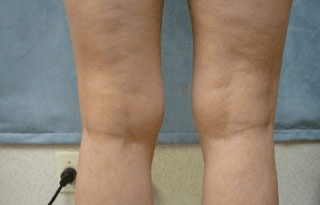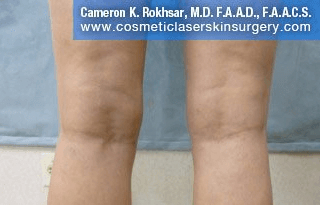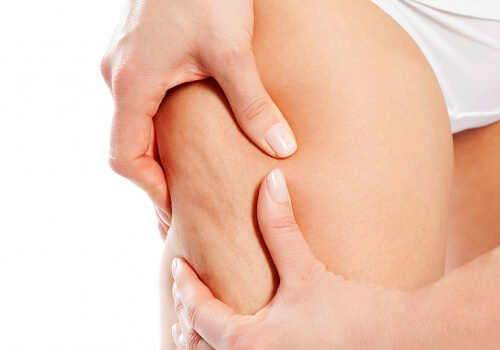Cellulite Treatment in New York
Get Rid of Cellulite
If there’s one word that generates a kind of common dread among many people, it might be “cellulite.” Even people who don’t know what cellulite is are pretty sure they don’t want to have it. During those hot New York City summers, cellulite can be particularly difficult to hide. But what exactly is cellulite?
Cellulite is deposits of fat and other material trapped in pockets of connective tissue beneath the skin. It causes progressive dimpling, also called “orange peel” or “cottage cheese” appearance of the skin. About 90 % of women are affected by it after they reach puberty so it is fairly normal to have. Cellulite is caused by factors that influence where and how fat is stored, where and how fluid is retained, and the amount and arrangement of collagen and elastin fibers in the connective tissue layers of the skin.
Factors influencing cellulite include:
- Genetic predisposition
- Hormones
- Hydration
- Diet
- Exercise
- Stress
- Drugs
- Medications
When normal fatty tissue is stored, it is held in place by a network of collagen and elastin fibers and is supplied by a network of vascular and lymph vessels.
The term “cellulite” was coined in 1973 to refer to the dimpled appearance of the skin that some people have on their hips, thighs, and buttocks. This appearance is much more common in women than in men because of differences in the way fat, muscle, and connective tissue is distributed in men and women’s skin. Although female hormones may play a role in contributing to this fat distribution, cellulite is not treatable by hormone therapy.
Cellulite Treatment Options
There are plenty of over the counter Cellulite “solutions.” The only problem with most of them is that they don’t work. Part of this has to do with the fact that people aren’t entirely sure what causes cellulite in the first place. Some of it is genetic and some of it may have to do with environmental factors. In either case, it will most often take a cosmetic procedure to eliminate your Cellulite deposits.
Cellulite Treatment Before and After


* 35-year-old woman came for consultation in getting rid of excess fat/cellulite in her things. The tumescent liposuction was performed at her inner thighs.
*Results may vary.
The VelaSmooth™ is the first medical device for cellulite. The VelaSmooth combines vacuum suction, mechanical rollers, and heating through infrared light and bipolar RF energy. Reduction in cellulite and contouring of unwanted lumps, bumps, and bulges are the treatment goals for VelaSmooth; most patients achieve some reduction in circumferential measurement around treated areas.
If you’re interested in eliminating your Cellulite and enjoying smooth, healthy-looking skin, contact Dr. Cameron Rokhsar to schedule a confidential consultation. Dr. Rokhsar will be able to determine which procedures or techniques may be of the most benefit to you and most effective in eliminating your Cellulite. If you want smooth skin today, contact us immediately and get started on your transformation!
Cellulite Treatment FAQ
How does cellulite form?
Cellulite forms when fibrous connective cords that tether the skin to the underlying subcutaneous tissue, tighten irregularly. This tightening pulls down on the skin, while the normal layer of fat beneath the skin pushes upward, resulting in a puckering appearance of the skin, also referred to as an uneven surface or dimpling. Cellulite occurs when fat cells accumulate and push up against the skin, while the long, tough cords pull down. The amount of cellulite one has and how noticeable it is can be based on several factors, including genetics, age, hormones, lifestyle, and the relationship between the skin, connective tissues, and normal fat cells.
Additionally, hormonal changes during menstrual cycles, menopause, and pregnancy can affect the flow of blood and lymphatic drainage of fluids, which can lead to cellulite formation. Anything that alters the hormone balance, such as birth control pills, can result in more or less cellulite.
While cellulite is more common in women than men, anyone can develop it. Massage therapy can help by stimulating circulation and draining excess fluids, which can result in smoother-looking skin. Engaging in regular exercise can also make cellulite less noticeable by replacing fat with muscle, making the skin look smoother and firmer.
What causes cellulite in the legs?
Cellulite in the legs can be caused by a variety of factors. One major cause is hormonal changes, specifically a decrease in estrogen levels after menopause or childbirth. Genetics also play a role, as some individuals may be more predisposed to developing cellulite than others. Additionally, the accumulation of fat cells beneath the skin can push up against the skin while fibrous connective cords tether the skin to the underlying muscle, creating an uneven surface or dimpling. Weight gain can exaggerate the degree of cellulite. Age, thicker skin, and lifestyle factors such as poor diet, smoking, and lack of exercise may also contribute to the development of cellulite in the legs.
To reduce the appearance of cellulite on the legs, some experts recommend incorporating strength training exercises that target the thighs and glutes, as well as daily cardio exercise. Massages can also help stimulate circulation and drain excess fluids, smoothing out the lumpy appearance of cellulite. While there is no known cure for cellulite, these lifestyle changes can help reduce its appearance.
How to prevent cellulite?
Cellulite is a common condition that causes dimpled, uneven skin on areas such as the thighs, buttocks, and abdomen. While there is no surefire way to prevent cellulite, there are steps that you can take to reduce its appearance and potentially prevent it from developing in the first place.
One of the most effective ways to prevent cellulite is to maintain a healthy weight through a balanced diet and regular exercise. This can help to reduce the amount of fat stored in your body and decrease the likelihood of cellulite forming.
Another approach is to minimize your exposure to toxins, which can contribute to the development of cellulite. This can be achieved by avoiding processed foods and foods that are high in fat and refined sugars. Additionally, some experts suggest that detoxing your body through methods such as drinking plenty of water and eating antioxidant-rich foods may help to reduce the appearance of cellulite.
Finally, it is important to be cautious of certain treatments that claim to eliminate cellulite, such as injectables and spa treatments. While some may provide temporary improvement, there is no magic solution for getting rid of cellulite in a permanent way.
How to reduce cellulite?
While there is no guaranteed way to eliminate cellulite completely, there are various methods to help reduce its appearance. Here are some methods that may help:
- Use retinol cream: Applying 0.3% retinol cream has been shown to improve the appearance of cellulite. Retinol helps thicken skin, which reduces the dimpling. Such products are applied once or twice a day, and any effect from a retinol cream won’t be noticeable for six months or longer.
- Try CoolSculpting: While not the first pick from dermatologists for getting rid of cellulite, cryolipolysis, also known as CoolSculpting, can still be beneficial because it helps freeze fat cells.
- Get a vigorous massage: Some spas offer vigorous massage in areas where you might have cellulite. This can increase blood flow and reduce excess fluid. While these massages may help, the improvements won’t last. Most at-home therapies and spa treatments only diminish the dimples for several hours after treatment.
- Consider Acoustic Wave Therapy: A handheld device uses sound waves to break up cellulite, which can help reduce the appearance of cellulite.
- Injectables: Some doctors inject chemicals into the fat layer below the skin to encourage breakdown and make cellulite less noticeable. However, there are potential risks and side effects, so it’s important to discuss the pros and cons with a healthcare professional.
- Stay hydrated: Drinking water is another low-cost option that may help with cellulite. Not only does it keep you hydrated, but water also helps encourage circulation and lymphatic flow.
- Build muscle and lose weight: Building muscle and losing weight can help reduce the appearance of cellulite. Exercise, such as weight lifting, can help tone and tighten the skin. A healthy diet and exercise routine can also help with weight loss.
- Eat a healthy diet: Eating a healthy diet rich in fruits, vegetables, lean protein, and healthy fats can help improve skin health and reduce the appearance of cellulite.
- Use caffeine creams or scrubs: Topical creams or scrubs containing caffeine may help reduce the appearance of cellulite.
- Dr. Rokhsar has used the Thermitight procedure with success in improving cellulite on a long term basis. Dr. Rokhsar breaks up the fibrous bands of cellulite and also heats up the skin from inside out using injectable radiofrequency. The Thermitight is a 2-3 hour procedure performed in the office.
How to get rid of cellulite on legs?
Here are some methods that have been suggested to reduce the appearance of cellulite on legs:
- Weight loss: Shedding extra pounds and toning the body through exercise and strength training may be the most effective way to reduce cellulite on legs.
- Massage: Regular massage, whether done at home or with a professional massage therapist, has shown some promise in reducing the appearance of cellulite on legs.
- Laser treatment: Laser treatment like ThermiTight may help get rid of cellulite on legs. This treatment uses energy from radiofrequency to heat a probe which is inserted directly beneath the skin to heat the tissues and stimulate collagen production. The results are much better than those achieved through topical creams.
- Skincare regimens: Some skincare regimens, like dry brushing, moisturizing, and spray tanning, may reduce the appearance of cellulite on legs. Professional body shaping treatments or injectables are also available to reduce cellulite, although results are not immediate or long-lasting.
- Hormonal health: Some causes of cellulite on legs can be estrogen dominance, loss of collagen, genetics, and thinning of the outer layer of skin. Addressing fat loss, collagen strength, and hormonal health can help reduce cellulite on legs. Specific ways to achieve these goals include maintaining a healthy diet, exercising regularly, and taking supplements like collagen and antioxidants.
How to get rid of cellulite on butt?
Although there is no one-size-fits-all solution to getting rid of cellulite on the butt, there are several methods that may help reduce its appearance.
One effective method is to exercise regularly, which can help tone the muscles in the buttocks and reduce the appearance of cellulite. Some recommended exercises include step-ups, pop squats, glute bridges, jump lunges, and walking lunges. In addition, incorporating cardio exercises like walking hills or climbing stairs can help define the gluteal muscles.
Eating a healthy diet can also help reduce the appearance of cellulite on the butt. Limiting junk food like sugar, processed foods, and saturated fat, and increasing fiber intake can have a number of key benefits. Consuming too much salt can lead to fluid retention, which is linked to cellulite, so it’s recommended to avoid salty foods as well.
In addition to exercise and diet, some other treatments have been put forth for the reduction of cellulite on the butt. Laser treatments like ThermiTight can help firm the skin and reduce the appearance of cellulite. Dr. Rokhsar has achieved remarkable results using ThermiTight to reduce the appearance of cellulite on the abdomen, butt, and thighs.
How to get rid of cellulite on thighs?
Cellulite on thighs is a common concern among many people. While it may not pose any serious health risks, it can be unsightly and affect one’s self-confidence. Here are some ways to get rid of cellulite on thighs:
- Exercise regularly: Resistance training and cardio exercises such as cycling, dancing, and running can help diminish the appearance of cellulite on thighs. Resistance training firms and tones muscles, which can result in a smoother appearance around the hips and thighs as those muscles press against the skin.
- Eat a healthy diet: Eating a balanced and healthy diet that is low in fat and high in fiber can help reduce the appearance of cellulite. Avoid processed foods and limit your intake of sugar and salt.
- Try dry brushing: Gently brush your skin, starting at the feet, working your way up to the shoulders. Perform dry brushing for around 5 minutes, focusing on the cellulite-affected areas. This can help boost circulation and improve the appearance of cellulite.
- Get professional treatments: Various professional treatments are available to treat cellulite on thighs. These include laser and radiofrequency treatments, Thermitght cellulite treatment, acoustic wave therapy, and CoolSculpting. These treatments can help reduce the appearance of cellulite, but further study is needed to determine their effectiveness.
New York Office Locations
Upper East Side Manhattan Office
121 East 60th Street, Suite 8AB New York, NY 10022
(212) 285-1110
Long Island Office
901 Stewart Ave, Suite 240, Garden City, NY 11530
(516) 512-7616



 Dr. Rokhsar was chosen by
Dr. Rokhsar was chosen by 






